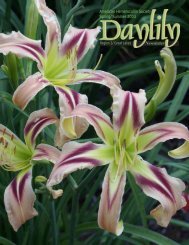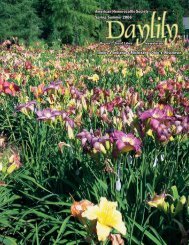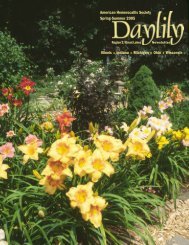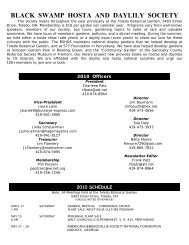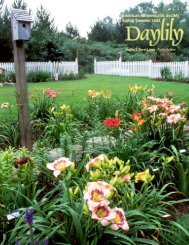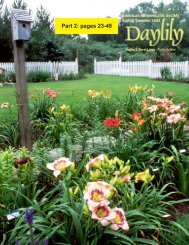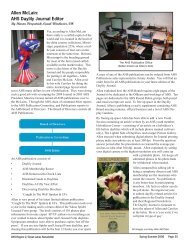Pages - AHS Region 2
Pages - AHS Region 2
Pages - AHS Region 2
You also want an ePaper? Increase the reach of your titles
YUMPU automatically turns print PDFs into web optimized ePapers that Google loves.
<strong>AHS</strong> <strong>Region</strong> 2/Great Lakes Newsletter<br />
<strong>Region</strong> 2 Symposium 2000 Recap<br />
(continued from page 29)<br />
John Rice talking about his<br />
Thoroughbred Daylilies<br />
his seedlings directly in the ground and usually–if he<br />
gets them in by early May–he will see bloom the following<br />
year. Sitting on a little scoot-about, John plants<br />
the seeds tightly, with about 1000 per 50 ft. row.<br />
John hybridizes primarily for large tetraploids, and he<br />
has a preference for blushes and colors that darken<br />
towards the edges. With that in mind, we enjoyed a<br />
sequence of slides showing past and new introductions<br />
and special seedlings from his program. John shared<br />
his thoughts about these daylilies with us, particularly<br />
his excitement for ANGEL’S BRAID (J. Rice 2000).<br />
He noted that ANGEL’S BRAID (ADMIRAL’S BRAID x<br />
ANGEL’S SMILE) was much easier to use than its parents<br />
and that this strong dormant cultivar was “throwing”<br />
a lot of exciting kids with patterns and the trait of<br />
roundness into the gene pool. He noted that WES KIRBY<br />
was one his better introductions and that JIM SPEN-<br />
CER was a strong early opener.<br />
This year’s introduction of YOU LOOK MARVELOUS is<br />
a branching wizard which has up to eight branches<br />
growing in the garden. He noted seeing nine branches<br />
on plants growing in the greenhouse.<br />
While he showed more slides of his introductions, I kept<br />
thinking about the different and incredible edges and<br />
colors he has created.<br />
Then, he showed us what is still to come. As John<br />
clicked through his seedling slides, I scribbled lots and<br />
lots of “to die for” comments all over my notes.<br />
Now, as I think back to the March 2000 presentation<br />
and see which of his creations I now have in my gardens,<br />
the “to die for” comment is a mild one.<br />
Especially notable were those ANGEL’S BRAID “kids”<br />
and several seedlings which had SALEM WITCH<br />
(Moldovan 1995) as one parent. John noted that SA-<br />
LEM WITCH, SHAKU ZULU (Moldovan 1992), and ARA-<br />
BIAN MAGIC (J. Salter 1992) had delighted him with<br />
the color range they produced in their “kids.”<br />
This is one up-and-coming hybridizer, one who has an<br />
eye for the new and distinctive features everyone of us<br />
is looking for. He is a wonderful gentleman with a wit<br />
and a focus that will take him far.<br />
Keep your our eyes es peeled for what’s coming from<br />
om<br />
Thoroughbred Gardens<br />
dens. . You ou won’t be disappointed.<br />
ed.<br />
<strong>AHS</strong> Daylily Dictonar<br />
onary (continued from page 2)<br />
a bitone and a bicolor. Not only are the descriptions<br />
here, but there are photographs to make it all crystal<br />
clear. In case you were always referring to a certain<br />
part of the bloom as the “watchamacallit,” you can go<br />
to the Daylily Image Map (on the bar at the top) and<br />
find Cheryl Postelwaite’s detailed drawing of a daylily<br />
with all the parts clearly labeled. A click on the<br />
“watchamacallit” (now positively identified as “stamen”)<br />
pulls up the definition of stamen and a great<br />
photo of them in living color. What could be easier<br />
The Dictionary isn’t meant to be a completed work;<br />
instead, it is a work in progress. Its creators, George<br />
Lawrence and Tim Fehr, are now working on the sec-<br />
ond flight of definitions to be added sometime this winter.<br />
George envisions detailed treatises on certain aspects<br />
of daylilies as well.<br />
As a sampler, click on Unusual Forms, Sculpted, or<br />
Edges. In the future, look for detailed discussions of<br />
doubles, polytepals, and seed starting, to name a few.<br />
Many many thanks go to George, Tim and all their<br />
contributors for all their hard work. This is definitely<br />
a labor of love for a flower.<br />
Melanie Mason, Director from <strong>Region</strong> 4<br />
Chairman, Publications Committee<br />
Jill Yost 2000<br />
Page 32 Fall 2000/Winter 2001



